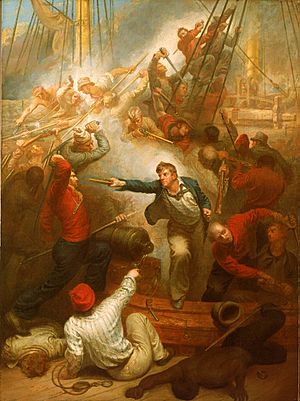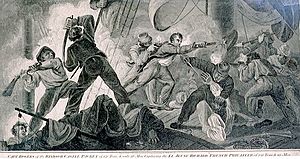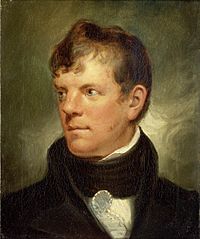Capture of the Jeune Richard facts for kids
Quick facts for kids Capture of the Jeune Richard |
|||||||
|---|---|---|---|---|---|---|---|
| Part of the Napoleonic Wars | |||||||
 Captain William Rogers Capturing the 'Jeune Richard', 1 October 1807, Samuel Drummond |
|||||||
|
|||||||
| Belligerents | |||||||
| Commanders and leaders | |||||||
| Strength | |||||||
| 1 packet ship | 1 privateer | ||||||
| Casualties and losses | |||||||
| 13 killed and wounded | 54 killed and wounded 1 privateer captured |
||||||
The capture of the Jeune Richard was an exciting sea battle that happened on October 1, 1807. It took place in the Caribbean during the Napoleonic Wars. This fight was between a British mail ship, the Windsor Castle, and a French privateer called the Jeune Richard.
A privateer was like a pirate ship, but it had permission from its government to attack enemy ships. The Windsor Castle was much smaller and had fewer crew members. Despite this, its acting captain, William Rogers, led his crew bravely. They not only defended their ship but also attacked and captured the Jeune Richard. This amazing victory made Rogers and his crew famous heroes. They were celebrated and rewarded for their courage.
Contents
A Mail Ship's Dangerous Journey
Setting Sail for the Caribbean
The Windsor Castle was a British packet ship. These ships were important because they carried mail, money, and passengers across the seas. In September 1807, the Windsor Castle left England. Its mission was to deliver mail to the Leeward Islands and Barbados.
Acting Captain William Rogers was in charge. His ship had six small 4-pounder guns and two larger 9-pounder carronades. A carronade is a short, powerful cannon. The crew was small, with only 28 men and boys.
Spotting the Enemy Ship
On the morning of October 1, 1807, the crew spotted another ship. By 8:30 AM, this mystery ship was sailing fast to catch them. Captain Rogers soon realized it was a French privateer schooner. He tried to escape, but the enemy ship kept getting closer. Rogers knew they would have to fight.
The enemy ship was the Jeune Richard. It was much stronger than the Windsor Castle. The Jeune Richard had six long 6-pounder guns and one very powerful 18-pounder gun. This meant it could fire much heavier cannonballs. It also had a huge crew of 92 men. That was more than three times the number of men on the Windsor Castle!
The Brave Battle at Sea
First Shots and Boarding Attempts
Captain Rogers got his ship ready for battle. He even prepared to sink the mail if needed, to keep it from falling into enemy hands. Around noon, the Jeune Richard got very close. It raised the French flag and began to fire its cannons. The Windsor Castle fired back.
The French captain shouted for Rogers to surrender. But Rogers refused! The Jeune Richard then pulled alongside the Windsor Castle. They threw grappling irons to hook the two ships together. The French privateers tried to climb aboard.
Fighting Off the Attackers
The crew of the Windsor Castle grabbed their pikes. Pikes are long spears. They fought off the French attackers bravely. They managed to kill or wound about eight to ten of the French boarders. The Jeune Richards crew tried to cut the ropes and pull away. But the Windsor Castles main mast stayed tangled in the privateer's ropes. This kept the two ships stuck together.
Turning the Tables
The battle continued for several hours. By 3 PM, the British crew had moved one of their 9-pounder carronades to the deck. They loaded it with a special mix of shots. This included grapeshot (many small balls), canister shot (like a giant shotgun shell), and 100 musket balls.
When the French tried to board again, the British fired this powerful cannon. It cleared the privateer's deck, causing many injuries and damage. Then, Captain Rogers led five of his men onto the Jeune Richard. They fought fiercely and forced the French crew away from their guns. They drove them below deck.
Securing the Prize
The French crew was trapped below, but they still greatly outnumbered the small British group on deck. Rogers had a clever plan. He ordered each Frenchman to come up on deck one by one. As they appeared, he had them put in irons. This way, the small British crew could control the much larger French crew.
A Hero's Welcome
Reporting the Victory
With the Jeune Richard now captured, Captain Rogers sailed both ships to the nearest British port. The battle had been tough. The British had three men killed and ten wounded. The French suffered much more, with twenty-one dead and thirty-three wounded.
Rogers then reported his amazing victory to Admiral Alexander Cochrane. Admiral Cochrane was very impressed. He sent Rogers' report to the Admiralty (the British Navy's headquarters). He added his own note, praising Rogers' bravery. He said Rogers showed "bravery and persevering courage, combined with great presence of mind, as was scarcely ever exceeded."
Fame and Rewards
News of Rogers' incredible victory spread quickly. People were amazed that a small mail ship had turned around and captured its much larger attacker. The story appeared in many newspapers and magazines.
Societies and groups started collecting money to reward Rogers and his crew. Besides money, Rogers received two swords and a special plate worth 100 guineas. He also got a vase worth £60. Most importantly, he was given command of another packet ship. An artist named Samuel Drummond painted Rogers' portrait and a picture of the battle. Other artists also created images to go with the newspaper stories.
|



